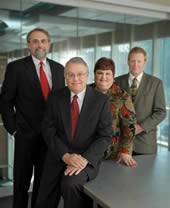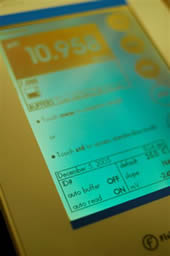UA’s Bama Technology Incubator
By Chris Bryant

Match one part University of Alabama faculty discovery with one part investor displaying an entrepreneurial spirit. Mix in a sound business plan, expert legal advice and top-notch communication facilities, alongside assistance with plan implementation. Ensure all these ingredients blend within a favorable environment.
The results from such a recipe? A successful startup company employing area residents and drawing from University of Alabama expertise.
That’s part of the planned formula behind the launching of UA’s Bama Technology Incubator. Housed within UA’s Alabama Institute for Manufacturing Excellence, the Bama Technology Incubator began in October of 2004.
“We try to provide a lot of services that would be cost prohibitive to a startup company,” said Dr. Daniel Daly, director of both technology transfer at UA and the University’s Alabama Institute for Manufacturing Excellence. “Just as the name incubator implies, it’s a protective shield that enables the company to start out with some insulation.”

Dr. Keith McDowell, vice-president for research at UA, said he envisions a time when obtaining patents on faculty discoveries and partnering with venture capitalists to launch startup companies becomes more routine for campus researchers.
“We want The University of Alabama to learn how to do this as a regular course of business,” McDowell said.
Research was once conducted as part of the “light-bulb generation” mindset, and patentable discoveries focused on complete inventions developed by researchers, said McDowell. That’s no longer the case. “This is the knowledge generation,” McDowell said. “The creation of new knowledge is an intellectual property.”
One example of an agreement between UA and a private company, centering around new knowledge developed at the University, can be found at Cr3 Inc.
Discoveries led by Dr. John Vincent, professor of chemistry at UA, led to multiple patents related to chromium’s potential use in treatment of diabetes and other diseases. The patents have been licensed to the Birmingham-based company, led by CEO Michael Alder. The company is pursuing use of the technology in a vitamin supplement.
The Incubator is designed to promote economic growth by boosting the number of tech companies in Alabama, administering programs to assist those companies, and facilitating access to technologies developed in UA’s laboratories, according to the Incubator’s developers.
Faculty members and researchers with patentable and marketable techniques and inventions are eligible to work with the Incubator, regardless of their areas of expertise, Daly said. “It doesn’t have to be tied to a technology that would typically be housed in the AIME,” Daly said.
Leaders of the Incubator include Daly, Dr. Marianne Woods, associate vice president for research at UA, and Michael Spearing, attorney in UA’s Office of Counsel.
If the discovery is deemed to have potential to lead to a reasonable chance of business success and if the researcher then agrees to join, the Incubator’s representatives will attempt to sell the intellectual property to a potential investor. Fifty percent of revenue streams generated by the company are returned to the researchers whose discoveries led to the launching of the company.
UA researchers who agree to partner with the Incubator serve as scientific advisers to the company, but they do not serve as the company’s business managers, Daly said. “We do not want these highly productive faculty members to become business managers; we want them to remain productive faculty members.”
In addition to the intellectual property and access to the brain power behind it, companies can benefit from the partnership through the business model UA can develop for them, the potential of leasing lab space to launch a pilot production facility, and the state of the art communication capabilities of the AIME facility, including high speed Internet and wireless capabilities and videoconferencing.

Having the option of hiring UA’s students, including those who may have worked closely with the researcher whose idea is being marketed, is another huge selling point, Daly said, as is the opportunity for the additional entrepreneurial training UA can offer a startup.
After three years in startup mode, the company, ideally would leave the protection of UA and become self-supporting at an off-campus location but one that is, ideally, not too far away, Daly said.
“We will strongly encourage the economic opportunities of this area,” Daly said.
Ventures such as those the Incubator seeks can be beneficial to UA as it can allow the University to recoup some of the costs it invests in seeking patents and business partners. Perhaps more importantly, Daly said, a successful Incubator program enhances the school’s stature in the eyes of productive faculty and potential faculty.
Further Reading
